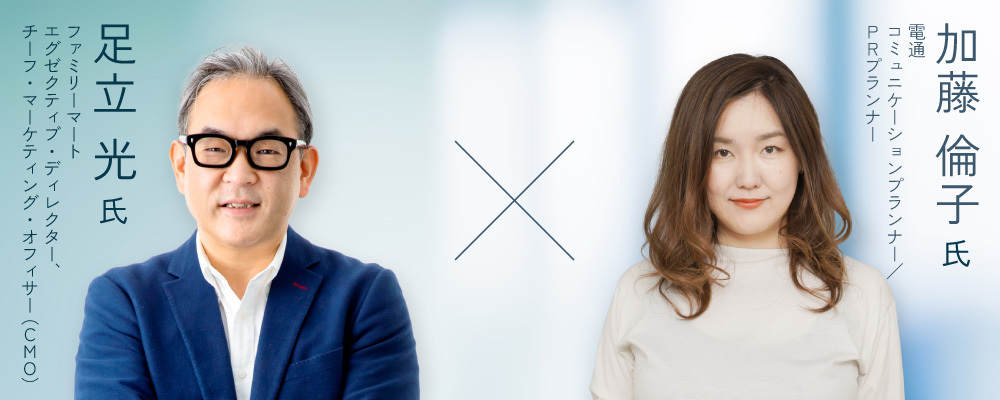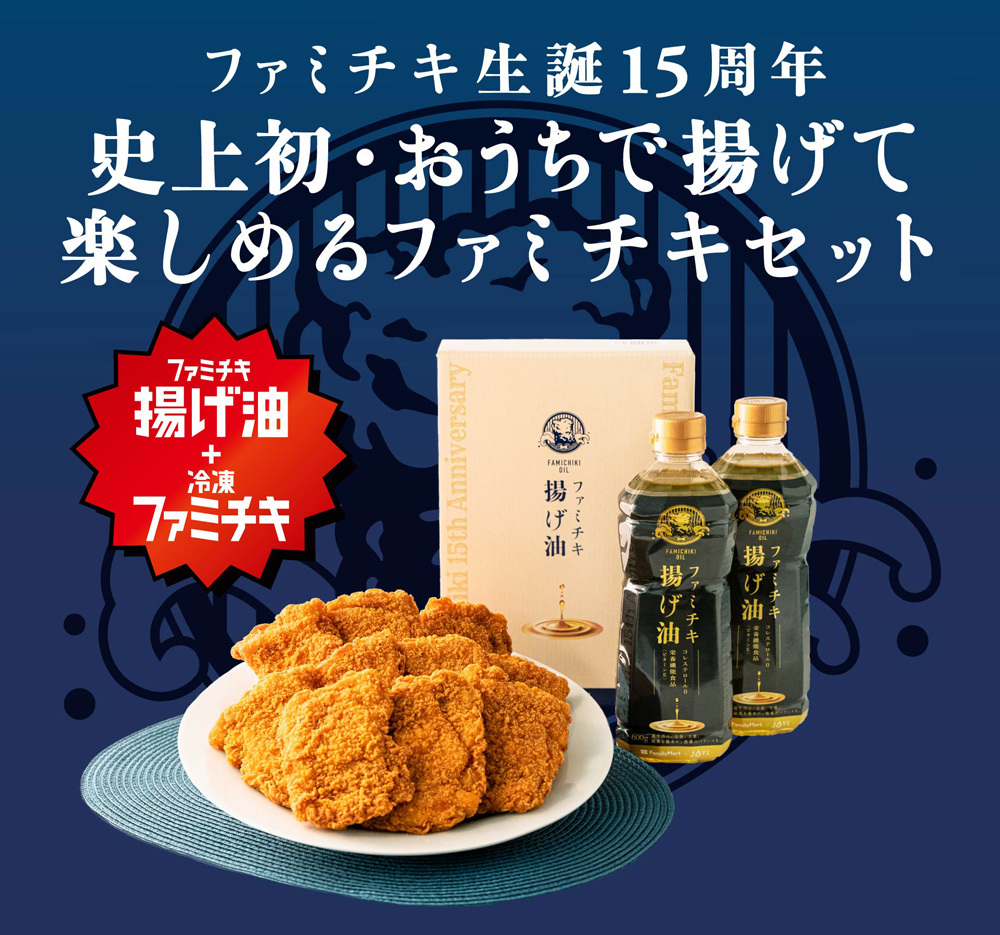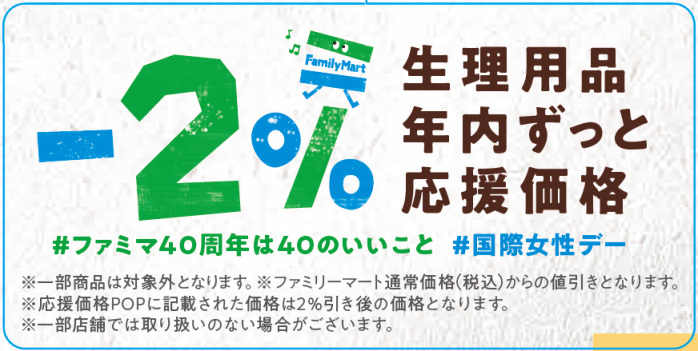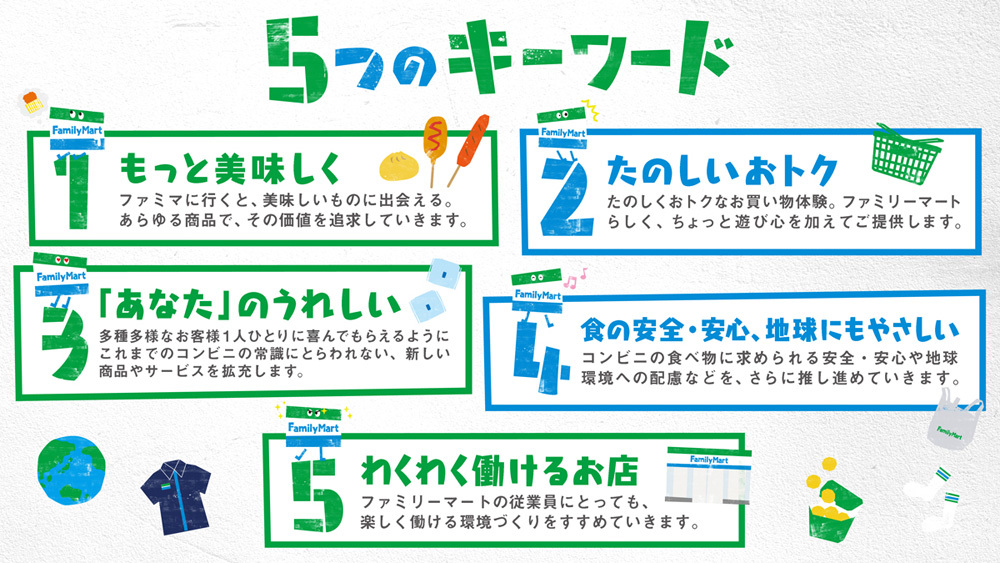As marketing theories evolve rapidly, traditional advertising-dependent strategies are increasingly failing to move people or products. Furthermore, with advertising budgets constrained, marketing professionals face the persistent challenge of how to grow customer numbers and sales.
In this series, FamilyMart CMO Hikaru Adachi, who planned, managed, and led the successful "FamilyMart 40th Anniversary Project," and Dentsu Inc. PR Planner Rinko Kato engage in a dialogue. While introducing the project's initiatives, they discuss "PR-driven CX (Customer Experience) Design."

The FamilyMart 40th Anniversary Project that led to "No. 1 in Convenience Store Customer Experience Value"
──FamilyMart ran its 40th Anniversary Project from March 2021 to February 2022 under the slogan "Famima-ru. (Encouraging visits to FamilyMart stores through various triggers)." It generated significant buzz, with sales exceeding the previous year's figures in nearly every month of fiscal 2021. It also ranked first in the convenience store industry in the "Customer Experience Value Ranking 2021." First, please tell us how each of you was involved in the campaign.
Adachi: I was the overall project leader. Beyond this specific campaign, as FamilyMart's CMO, I oversee all marketing. My primary roles are threefold: First, ensuring nearly everything customers see—advertising, PR, social media posts, product packaging—maintains consistent, strong communication from the customer's perspective. Second, increasing customer visits. Third, to achieve this, engaging with the entire "marketing mix" (the 4Ps) encompassing not just promotions, but also product development, pricing, and distribution channels.
Kato: I was involved in this campaign as Creative Director. My role extended beyond devising ad copy and key visuals. I took a broad perspective, contributing from the initial action planning stage to determine how FamilyMart's various activities could generate buzz and drive customer visits.
──Please tell us about the campaign's outline.
Adachi: We communicated the image we wanted customers to have of FamilyMart through five keywords, then launched various initiatives based on each keyword under the theme "40 Good Things!?".

Kato: For example, under the keyword "Even More Delicious," we launched the new "Crispy Chicken," aiming to make it a flagship product alongside "Famichiki." Under the keyword "Fun Savings," we increased the portion size of popular items like sandwiches by 40%.
We continuously shared news like this through press releases, social media, in-store boards, and POP displays. As a result, by the end of the campaign in late February 2022, the number of "Good Things!?" we had shared had far exceeded 40, reaching 100.
──Please explain the strategy behind creating and sharing these "40 Good Things!?" continuously.
Adachi: I've seen many anniversary projects, but few directly translate into sales. For FamilyMart's 40th anniversary, I felt we absolutely had to implement measures that genuinely increased customer numbers and sales. The 40th anniversary itself is merely a "trigger" for customers and the media. Therefore, while promoting the 40th anniversary, it was crucial to execute numerous meaningful initiatives for customers under that umbrella.
Kato: Ultimately, we executed 100 initiatives. This campaign involved seven agencies, including Dentsu Inc., who developed various strategies. Dentsu Inc. not only proposed initiatives but also oversaw the entire project. We held weekly meetings with members from FamilyMart's PR and Marketing departments to discuss what news to release and then implemented it.
──What did you prioritize most in this effort?
Adachi: One was consistently releasing news aligned with the five keywords. Another was ensuring sales didn't drop significantly week to week or month to month. We balanced the five keywords while aiming to release news weekly as much as possible.
Kato: It was challenging, but our main concern was always: "How can we ensure each individual initiative is perceived as valuable to customers?"
Adachi: Our criteria for selecting proposed initiatives were: "Will customers appreciate it?", "Does it showcase FamilyMart's unique characteristics?", and "Are we doing something competitors find difficult?" We focused on promoting initiatives that met all three criteria as much as possible.
We don't need news (initiatives) that only become a topic for a moment!
──Among the "40 Good Things!?", "Famichiki" and "Crispy Chicken" became major talking points. Please explain the aim of these initiatives.
Adachi: Among the 100 good things we announced over the year, chicken-related news seemed particularly prominent. We focused so heavily on chicken because it's our flagship product and a high-priority strategic category.
Kato: Our mission for the chicken initiatives was to convey "deliciousness" with an element of surprise. It wasn't just about creating a fleeting buzz through advertising; it was crucial to continuously generate newsworthy content that ultimately drove sales for our core products. Merely getting a little media coverage and becoming a topic of conversation isn't enough. Mr. Adachi has consistently emphasized from the start that we need all three: "buzz, store visits, and sales."
Adachi: Products without buzz won't sell, but buzz alone doesn't guarantee sales. The key is the focus of the buzz. For chicken, it's solely about whether the deliciousness comes across clearly and whether it makes people want to eat it. We don't need any other buzz. Creating buzz is easy, but if it doesn't translate into actual customer numbers and sales, it's completely meaningless.
Kato: But making "deliciousness" a talking point is difficult, right? It's obvious for a food company to say their product is "delicious." That's why, for the chicken campaign, we also proposed the "Famichiki Set for Home." This is a set selling "frozen Famichiki" and "Famichiki frying oil." We thought having customers make it at home would convey just how surprisingly delicious Famichiki is, and it would also serve as proof of one of FamilyMart's five core principles: "Safety and Security." This initiative relied solely on PR and social media, yet it became a hit, topping e-commerce sales and getting featured by popular YouTubers. Ultimately, I believe it helped broaden the base of chicken users.

Adachi: There were two key points for chicken initiatives. First, aside from the initial "Crispy Chicken" launch, all products were existing items. We asked Mr. Kato and his team to strategize how to make these trending. Second, while many chicken eaters consume large quantities, non-consumers avoid it entirely. Therefore, we approached initiatives from two perspectives: encouraging regular consumers to eat more, and encouraging non-consumers to try it.
For example, during the "Famichiki 15th Anniversary" campaign, we ran the "Famichiki King Championship," where customers competed to see who could buy the most Famichiki for prizes. This time, we promoted the product with the copy: "If you've never tried Famichiki, you're missing out on life!" For Christmas, we sold our "Premium Chicken," an improved version of our regular product, alongside the tagline "FamilyMart is Japan's second most popular chicken shop!" Both campaigns used catchy copy to effectively communicate the product's deliciousness while aiming to generate buzz.
Kato: Even with just chicken, we focused on conveying "delicious" and "makes you want to eat it," using every trick in the book to create news. It actually became a major talking point and drove sales, which was incredibly rewarding.
All initiatives originated from a PR perspective
──Among the "40 Good Things!?", there were also initiatives rooted in social issues, like offering a 2% discount on sanitary products in conjunction with International Women's Day. Could you explain the background of these initiatives?
Kato: FamilyMart has stores nationwide, and many people use them almost daily. We recognized this as significant influence. That's why we proposed initiatives linked to social topics. One example was the "2% discount on sanitary products campaign," launched the day after March 8th's International Women's Day, which generated substantial buzz. Both this initiative and the earlier "Crispy Chicken" campaign were executed during the early phase of our 40th anniversary project. I feel these two effectively set the direction for FamilyMart's 40th anniversary campaign in a positive way.
While the "2% Discount on Feminine Hygiene Products" campaign could be seen as a simple product discount, it established a new PR-driven direction: creating actions that address social issues in-store and turning them into news.

Adachi: Most of the initiatives we implemented for the 40th anniversary project were PR-driven. We started by considering how to communicate them effectively to generate buzz, because most initiatives weren't advertised. We chose to build awareness through PR and social media.
Kato: For the menstrual products initiative, we also avoided ads, relying instead on in-store POP displays and SNS. The activities tied to International Women's Day themselves became the topic of conversation, making it a huge success in terms of PR impact.
Adachi: In marketing, we view owned media—including stores—and earned media like PR and SNS as complementary to paid media, such as mass advertising. Therefore, we always prioritize owned and earned media first, carefully designing paid (advertising) to complement and reinforce them. For campaigns, we first decide what to communicate via in-store signage and posters (owned media), finalize the most impactful messaging there, then plan social media outreach. Depending on the initiative, we may then roll out advertising.
Kato: For the 40th anniversary project, Mr. Adachi told us upfront, "Please don't start with a TV commercial (paid media) proposal." Everything began with the store signage and press releases. It was enjoyable to plan projects that cleverly utilized various in-store elements as media, as they offered so many opportunities for communication and storytelling. When you look at articles covering the 40th anniversary initiatives, you'll often see visuals or thumbnails that effectively utilize the storefront. That was indeed the goal, and it really drove home the point: the store itself is the ultimate medium and the place where people actually see things.
To be continued.













